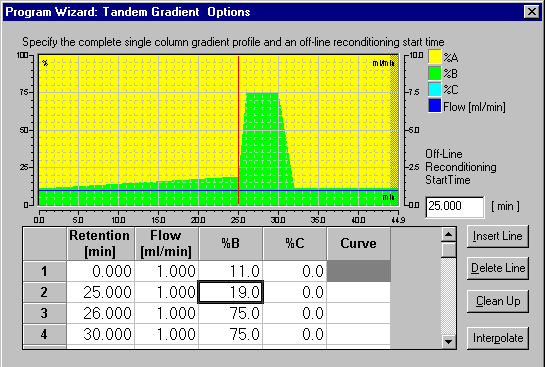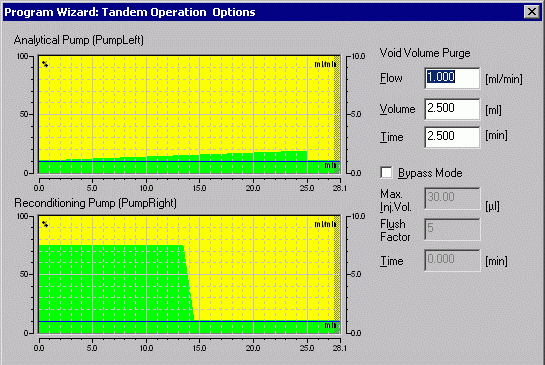Creating and Modifying Programs
![]() Defining Tandem Gradients (UltiMate 3000 x2/Summit x2)
Defining Tandem Gradients (UltiMate 3000 x2/Summit x2)
The UltiMate 3000 x2 Dual-Gradient HPLC-System as well as the Summit x2 Dual-Gradient HPLC System feature Tandem Operation. Running the system with two separate pumps that deliver at the same flow rate or a dual-gradient pump, a second column, and a 10-port valve allows a significant increase in sample throughput (an increase of 50% to 100% is typical). After the active gradient during which all important substances eluted from the column, the column is excluded from the chromatography flow and reconditioned offline. The re-equilibration time of the column is used to analyze the next sample on the second column.
The Program Wizard supports tandem operation only if either
the selected timebase includes an UltiMate 3000 x2 Dual Gradient System and if a 10-port valve is selected on the Components tab page for the TCC-3x00 in the Server Configuration, or
the selected timebase includes a Summit x2 Dual-Gradient HPLC System and if the motorized switching valve (MSV) is selected for the TCC-100 on the Configuration page in the Server Configuration program.
For more information about the wizard, refer to The Control Program ![]() The Program Wizard. On the Wizard Options page, select Program for x2 Tandem Operation and follow the instructions in the wizard to create the program.
The Program Wizard. On the Wizard Options page, select Program for x2 Tandem Operation and follow the instructions in the wizard to create the program.
On the Tandem Gradient Options page, determine the (virtual) profile, assuming that only one pump is installed. The picture graphically represents this virtual profile.

Determining the start for off-line reconditioning
To determine when off-line reconditioning begins, enter a time value in the Off-line Reconditioning Start Time input field.
![]() Note:
Note:
Starting off-line reconditioning does not mean that the column switching valve immediately switches to the other column. Before the valve can switch, the solvent lines between the pump and the column switching valve must be purged. This ensures that only solvent of the starting composition is transported to the second column. In this way, the second column is optimally conditioned when the next sample is injected.
Set the start of the off-line reconditioning to a retention time at which all peaks have eluted from the column. Alternatively, draw the red line in the graphical representation to the desired gradient position. Note that you can draw the line only to certain values, e.g., the basic points of the gradient. In the input field, you can enter the time with three places after the decimal point.
The pictures on the Tandem Operation Options page represent the gradients actually delivered by the two pumps.

![]() Tip:
Tip:
The virtual gradient on the Tandem Gradient Options page may appear to be shorter than the actual gradients on the Tandem Operation Options page. This is because the time required to purge the void volume is not considered for the virtual gradient.
The (virtual) gradient (defined in the table) is delivered by the analytical pump until off-line reconditioning starts. Then, the analytical pump flushes the solvent lines between the pump and the column switching valve. The column switching valve cannot switch to the other column until after the solvent lines have been completely purged. Afterward, the reconditioning pump delivers the remaining (virtual) gradient that has not yet been delivered by the analytical pump, starting with the composition that contains a minimum of solvent A. If the second part of the original virtual profile is shorter than the first part, the time for the minimum %A portion is prolonged to ensure that the other times of the actual reconditioning profile correspond to the original virtual profile.
For program examples, refer to:
![]() Creating a Tandem Program (including Bypass Mode) for an UltiMate 3000 HPLC System
Creating a Tandem Program (including Bypass Mode) for an UltiMate 3000 HPLC System
![]() Creating a Tandem Program (including Bypass Mode) for a Summit HPLC System
Creating a Tandem Program (including Bypass Mode) for a Summit HPLC System